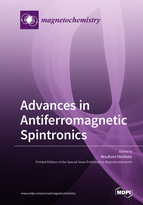Advances in Antiferromagnetic Spintronics
A special issue of Magnetochemistry (ISSN 2312-7481). This special issue belongs to the section "Spin Crossover and Spintronics".
Deadline for manuscript submissions: closed (20 November 2021) | Viewed by 22250
Special Issue Editor
Interests: spintronics; half-metallic ferromagnets; quantum nanoelectronics; nano-spintronic devices
Special Issues, Collections and Topics in MDPI journals
Special Issue Information
Dear Colleagues,
Antiferromagnetic spintronics is one of the emerging topics in spintronics due to a wide range of advantages, including terahertz operation, no stray field, and highly efficient spin generation. The discussion of this topic covers aspects ranging from the development of new antiferromagnetic materials to the applications of these materials in devices. Traditionally, antiferromagnets were treated as less common magnetic materials for fundamental studies and applications. However, recent miniaturisation and high-frequency operation have revealed them to be advantageous over the conventional ferromagnets. This Special Issue reviews the current status and future perspectives of antiferromagnetic spintronics.
Prof. Dr. Atsufumi Hirohata
Guest Editor
Manuscript Submission Information
Manuscripts should be submitted online at www.mdpi.com by registering and logging in to this website. Once you are registered, click here to go to the submission form. Manuscripts can be submitted until the deadline. All submissions that pass pre-check are peer-reviewed. Accepted papers will be published continuously in the journal (as soon as accepted) and will be listed together on the special issue website. Research articles, review articles as well as short communications are invited. For planned papers, a title and short abstract (about 100 words) can be sent to the Editorial Office for announcement on this website.
Submitted manuscripts should not have been published previously, nor be under consideration for publication elsewhere (except conference proceedings papers). All manuscripts are thoroughly refereed through a single-blind peer-review process. A guide for authors and other relevant information for submission of manuscripts is available on the Instructions for Authors page. Magnetochemistry is an international peer-reviewed open access monthly journal published by MDPI.
Please visit the Instructions for Authors page before submitting a manuscript. The Article Processing Charge (APC) for publication in this open access journal is 2700 CHF (Swiss Francs). Submitted papers should be well formatted and use good English. Authors may use MDPI's English editing service prior to publication or during author revisions.
Keywords
- Antiferromagnets
- Compensated ferrimagnets
- Spintronics
- Spin current
- Spin Hall effect
- Spin caloritronics






